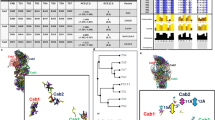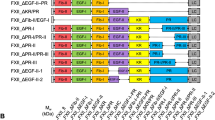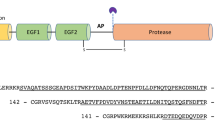Abstract
Reversible membrane binding of γ-carboxyglutamic acid (Gla)-containing coagulation factors requires Ca2+-binding to 10–12 Gla residues. Here we describe the solution structure of the Ca2+-free Gla-EGF domain pair of factor X which reveals a striking difference between the Ca2+-free and Ca2+-loaded forms. In the Ca2+-free form Gla residues are exposed to solvent and Phe 4, Leu 5 and Val 8 form a hydrophobic cluster in the interior of the domain. In the Ca2+-loaded form Gla residues ligate Ca22+ in the core of the domain pushing the side-chains of the three hydrophobic residues into the solvent. We propose that the Ca2+-induced exposure of hydrophobic side chains is crucial for membrane binding of Gla-containing coagulation proteins.
This is a preview of subscription content, access via your institution
Access options
Subscribe to this journal
Receive 12 print issues and online access
$189.00 per year
only $15.75 per issue
Buy this article
- Purchase on Springer Link
- Instant access to full article PDF
Prices may be subject to local taxes which are calculated during checkout
Similar content being viewed by others
References
Furie, B. & Furie, B.C. The molecular basis of blood coagulation. Cell 53, 505–518 (1988).
Mann, K.G., Nesheim, M.E., Church, W.R., Haley, P. & Krishnaswamy, S. Surface-dependent reactions of the vitamin K-dependent enzyme complexes. Blood 76, 1–16 (1990).
Davie, E.W., Fujikawa, K. & Kisiel, W. The coagulation cascade: Initiation, maintenance and regulation. Biochemistry 30, 10363–10367 (1991).
Nelsestuen, G.L. & Suttie, J.W. Mode of action of vitamin K. Calcium binding properties of bovine prothrombin. Biochemistry 11, 4961–4964 (1972).
Stenflo, J. & Ganroth, P.O. Binding of Ca2+ to normal and dicoumarol-induced prothrombin. Biochem. biophys. res. Commun. 50, 98–104 (1973).
Henriksen, R.A. & Jackson, C.M. Cooperative calcium binding by the phospholipid binding region of bovine prothrombin: A requirement for intact disulphide bridges. Arc. Biochem. Biophys. 170, 149–159 (1975).
Bajaj, S.P., Butkowski, R.J. & Mann, K.G. Prothrombin fragments: Ca2+binding and activation kinetics. biol. Chem. 250, 2150–2156 (1975).
Stenflo, J. & Suttie, J.W., K-dependent formation of γ-carboxyglutamic acid. A. Rev. Biochem. 46, 157–172 (1977).
Suttie, J.W., Vitamin K-dependent carboxylase. A. Rev. Biochem. 54 459–477 (1985).
Schwalbe, R.A., Ryans, J., Stern, D.M., Kisiel, W., Dahlbäck, B. & Nelsestuen, G.L. Protein structural requirements and properties of membrane binding by γ-carboxyglutamic acid-containing plasma proteins and peptides. J. biol. Chem. 264, 20288–20296 (1989).
Soriano-Garcia, M., Padmanabhan, K., deVos, A.M. & Tulinsky, A. The Ca2+ion and membrane binding structure of the Gla domain of Ca-prothrombin fragment 1. Biochemistry 31, 2554–2566 (1992).
Park, C.H. & Tulinsky, A. Three-dimensional structure of the kringle sequence: Structure of prothrombin fragment 1. Biochemistry 25 3977–3982 (1986).
Tulinsky, A., Park, C.H. & Skrzypczak-Jakun, E. Structure of prothrombin fragment 1 refined at 2.8 Å resolution. J. molec. Biol. 202, 885–901 (1988).
Persson, E. et al. Calcium binding to the isolated β-hydroxyaspartic acid-containing epidermal growth factor-like domain of bovine factor X. J. biol. Chem. 264 16897–16904 (1989).
Persson, E., Björk, I. & Stenflo, J. Protein structural requirements for Ca2+ binding to the light chain of factor X. Studies using isolated intact fragments containing the γ-carboxyglutamic acid region and/or the epidermal growth factor region. J. biol. Chem. 266, 2444–2452 (1991).
Ullner, M. et al. Three-dimensional structure of the apo form of the N-terminal EGF-like module of blood coagulation factor X as determined by NMR spectroscopy and simulated folding. Biochemistry 31, 5974–5983 (1992).
Selander-Sunnerhagen, M. et al. How an epidermal growth factor (EGF)-like domain binds calcium. J. biol. Chem. 267, 19642–19649 (1992).
Linse, S., Teleman, O. & Drakenberg, T. Ca2+-binding to Calbindin D9k strongly affects backbone dynamics: Measurements of exchange rates of individual amide protons using 1H NMR. Biochemistry 29, 5925–5934 (1990).
Valcarce, C. et al. Calcium affinity of the amino-terminal epidermal growth factor-like module of factor X. Effect of the gamma-carboxyglutamic acid-containing module. J. biol. Chem. 268 26673–26678 (1993).
Johnson, M.S., Overington, J.P. & Blundell, T.L. Alignment and searching for common protein folds using a data bank of structural templates. J. molec. Biol. 231, 735–752 (1993).
Johnson, M.S. & Overington, J.P. A structural basis for sequence comparisons: An evaluation of scoring methodologies. J. molec. Biol. 233 716–738 (1993).
Ratcliffe, J.V., Furie, B. & Furie, B.C. The importance of specific γ-carboxy-glutamic acid residues in prothrombin. J. biol. Chem. 268, 24339–24345 (1993).
Zhang, L., Jhingan, A. & Castellino, F.J. Role of individual γ-carboxy glutamic acid residues of activated human protein C in defining its in vitroanticoagulant activity. Blood 80, 942–952 (1992).
Zhang, L. & Castellino, F.J. The binding energy of human coagulation protein C to acidic phospholipid vesicles contains a major contribution from leucine 5 in the γ-carboxy glutamic acid domain. J. biol. Chem. 269, 3590–3595 (1994).
Govers-Riemslag, J.W.P., Janssen, M.P., Zwaal, R.F.A. & Rosing, J. Prothrombin activation on dioeoylphosphatidylcholine membranes. E. J. Biochem. 220, 131–138 (1994).
Resnick, R.M. & Nelsestuen, G.L. Prothrombin-membrane interaction. Effects of ionic strength, pH and temperature. Biochemistry 19,3028–3033 (1980).
Concha, N.O., Head, J.F., Kaetzel, M.A., Dedman, J.R. & Seaton, B., Rat Annexin V crystal structure: Ca2+-induced conformational changes. Science 261, 1321–1324 (1993).
Meers, P. & Mealy, I. Relationship between Annexin V tryptophan exposure, calcium and phospholipid binding. Biochemistry 32, 5411–5418 (1993).
Zozulya, S. & Stryer, L. Calcium-myristoyl protein switch. Proc. natn. Acad. Sci. U.S.A. 89, 11569–11573 (1992).
Dizhoor, A.M. et al. Role of the acylated amino terminus of recoverin in Ca2+-dependent membrane interaction. Science 259, 829–832 (1993).
Clore, G.M., Brünger, A.T., Karplus, M. & Gronenborn, A.M. Application of molecular dynamics with interproton distance restraints to three-dimensional protein structure determination. J. molec. Biol. 191, 523–551 (1986).
Brooks, B.R. et al. CHARMM: A program for macromolecular energy, minimization and dynamics calculations. J. comp. Chem. 4, 187–191 (1983).
Author information
Authors and Affiliations
Rights and permissions
About this article
Cite this article
Sunnerhagen, M., Forsén, S., Hoffrén, AM. et al. Structure of the Ca2+-free GLA domain sheds light on membrane binding of blood coagulation proteins. Nat Struct Mol Biol 2, 504–509 (1995). https://doi.org/10.1038/nsb0695-504
Received:
Accepted:
Issue Date:
DOI: https://doi.org/10.1038/nsb0695-504
This article is cited by
-
Kinetic regulation of the binding of prothrombin to phospholipid membranes
Molecular and Cellular Biochemistry (2013)
-
Structural basis of membrane binding by Gla domains of vitamin K–dependent proteins
Nature Structural & Molecular Biology (2003)
-
The crystal structure of the complex of blood coagulation factor VIIa with soluble tissue factor
Nature (1996)



